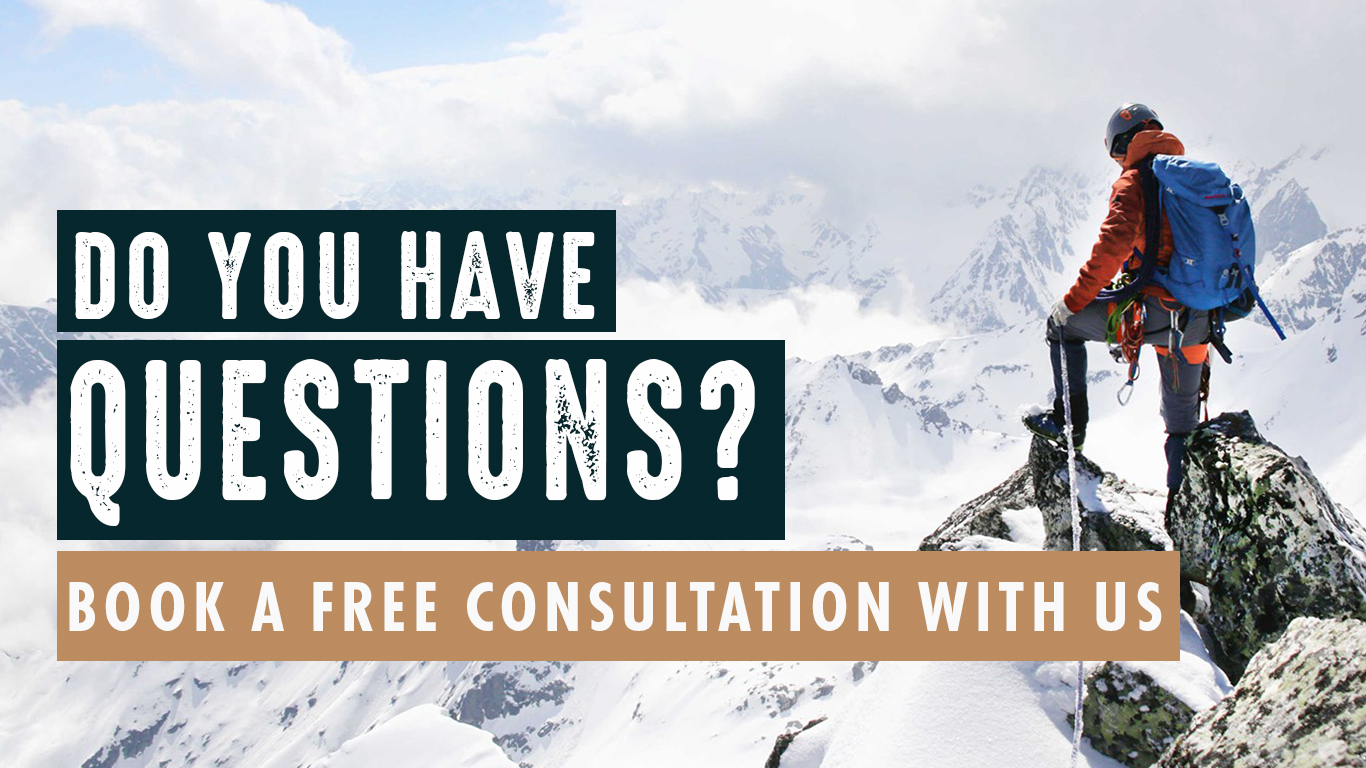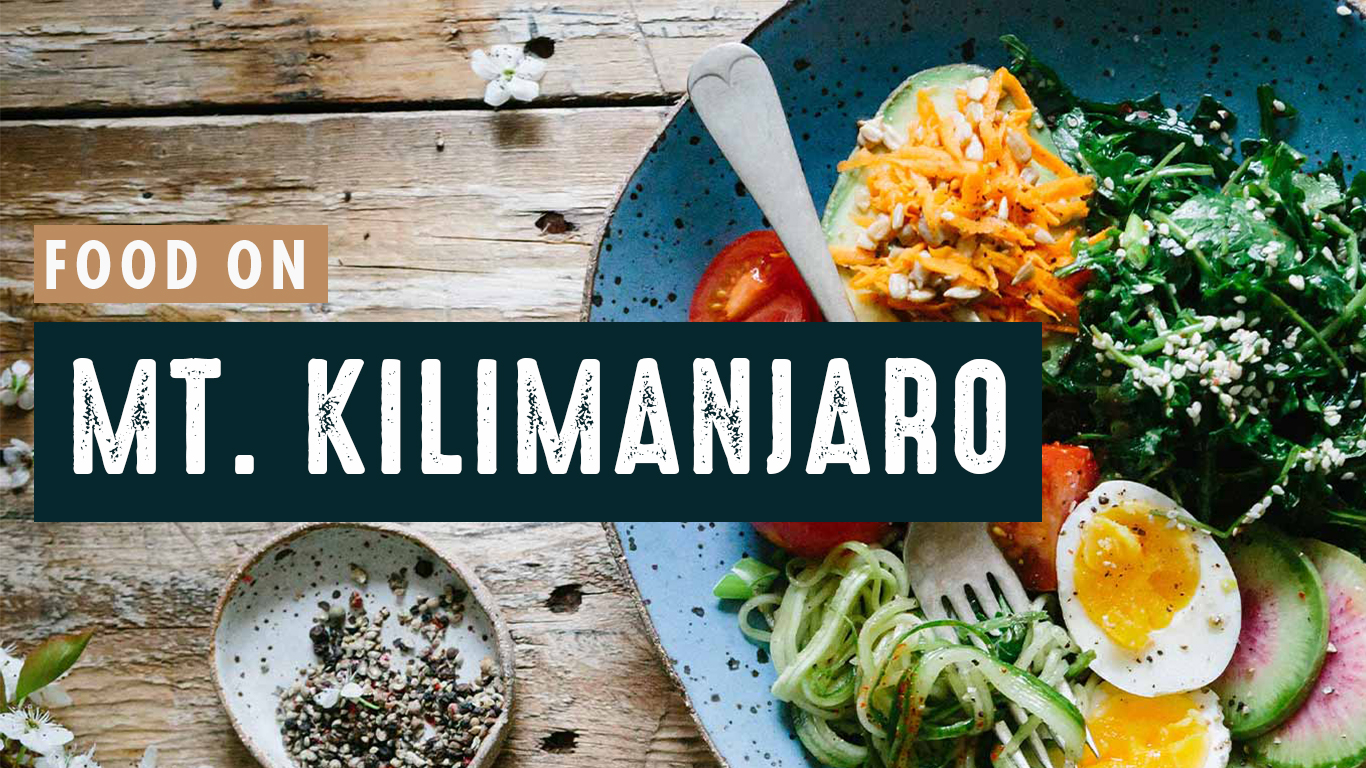“Babu, are you awake? It’s time to go.”
It’s 10:30 p.m., the night of our Mount Kilimanjaro summit climb, and our guide Mark has come
to my tent. We had completed a thorough equipment check that afternoon, grabbed a quick nap
after dinner, and carefully laid out all our warm clothes, headlamps, water and food, and in my
case, a small wooden cross to keep close in my pocket. We’re on the trail toward the summit by
11, starting from Barafu Camp at 15,300 feet with the goal of the top of Kilimanjaro at 19,000
feet and 3 miles up. At our pole, pole, pole pace – slow, slow, slow – we won’t be near the
summit until dawn.
In the dark, the mountain is defined only by its massive dark shape blocking out the night sky,
and a long line of tiny white dots going straight up its spine from the headlamps of other hikers
ahead of us. The four of us – two guides and two hikers – move without conversation, the only
sound breaking the silence the steady tapping of our trekking poles on the rocky trail. I’m
absorbed in a blend of nervousness and excitement, in a very foreign place and at an altitude
higher than I’ve ever hiked. But the unknown has been my constant companion in Africa over
the past week, and I’ve learned facing it is just a matter of one step at a time – this time literally.
But within two hours, doubt has crept into the picture, like the fog that drifted up to our camp
earlier in the evening. I’m having trouble settling into a steady, comfortable breathing pattern.
My heart rate feels elevated, and nothing seems to bring it down. We have hours to go, and I
can’t conceive how I can last until dawn. I’m into something somewhere over my head, and I
start to wonder if it’s smart for me, at age 68, to be on this mountain. And I ask what I’m doing
here in the first place.
A Once in a Lifetime Challenge
For me the journey started two decades ago and involves an organization called the
Leukemia & Lymphoma Society (LLS), which raises money for blood cancer research and programs that support patients and their families. I became involved in LLS after my own treatment for a rare
form of leukemia in 2001. One of the ways LLS raises money is through endurance athletic
events – triathlons, marathons, bike rides and, in this case, hiking and climbing expeditions.
After I finished chemotherapy, I heard about the LLS program and quickly signed up as a way to
start giving back to a science that basically saved my life. Just a few decades before my
diagnosis and treatment, hairy cell leukemia was a fatal disease. Research had found an
effective chemotherapy. Since my first event in 2002 – the 200-mile Seattle to Portland bike ride
– I have chosen an annual event to participate in and raise funds for, completing some 30
triathlons and bike rides all along the West Coast and as far away as Austin, Texas, and New
York City.
One LLS program – Climb2Cure – was always on my list. It turned out that the Kilimanjaro trip
through Embark Exploration was a doable option in 2024 and I signed up. At the same time, I
was searching for something in my life – something big and challenging and far away where I
could go to ponder and unpack and gain perspective at a huge turning point for me: retirement. I
needed a long philosopher’s walk to go back over the past 30 years, and peer into what might be ahead. It needed to be far enough out of my comfort zone to do the trick. What could be
better than climbing the highest mountain in Africa? I signed up for a March (2024) trip.
Training started four months prior to the trip with Embark’s week-by-week calendar of workouts,
walks and hikes, increasing in intensity over time. We started with something as simple as a
two-hour hike with no elevation gain on the first weekend, culminating with a final weekend of
Saturday and Sunday back-to-back workouts of five-plus hour hikes with 2,500-3,000 feet of
elevation gain with 25-pound packs. I maximized the trail network close to my home outside of
Seattle for these workouts. “Bring the best version of yourself to the mountain” was the advice
given by Embark. Check that box.
Journey to Africa
The flights from Seattle to San Francisco to Amsterdam to Kilimanjaro meant some 26 hours in
the air. As I arrived in the night at Kilimanjaro, I had a sinking feeling that my duffle bag with all
my hiking gear would not arrive. The bag carousel spun to a halt. My fears were realized:
among the two or three bags left on the belt, mine was not among them. The next day at our
hotel in Moshi as we met our trip leaders, I explained my predicament. Aside from my boots,
which I had kept with me in my carry-on backpack, the duffel bag had every carefully detailed
item, checked off Embark’s comprehensive packing list. All the warm clothes and waterproof
pants and jacket. Headlamp, tent light and a book. Water bottles. Energy gels for summit night. I
had even used packing cubes for the clothes – arranged in order of use.
“Don’t worry, we will take care of you. We will go to our rental store and get everything you
need,” promised our main contact in Moshi, Freddie. “Hakuna matata – don’t worry – it’s the
African way.” I forced a smile. Wasn’t hakuna matata from a movie – and this was real life. But
we went to the store, and indeed a half hour later I had a new duffel of essentials, a bit large or
small in some cases, but more than adequate. I let myself succumb a bit to hakuna matata. We
would hear it again.
The next morning our van took us out of Moshi past fields where we saw giraffes nibbling on
baobab trees and villages with a steady stream of people walking along the road carrying loads
of food and goods on their heads and shoulders. School children in their uniforms turned and
waved at the tour van as we passed. Our destination was the Lemosho Gate, one of several
entrances into Kilimanjaro National Park. The Lemosho Route, on the mountain’s western flank,
would take us 45 miles, starting in the rainforest and leading up to the summit, and finally out of
the park eight days later at the Mweka Gate. Lemosho is a popular choice because of its
gradual elevation gain, giving hikers the best chance to acclimate in the high mountain zone.
We would hike six days before the summit in manageable daily distances, with the goal of
keeping us above 10,000 feet and higher to acclimate.
We signed in on the official register at the gate. It was real now. Our guide, Mark, gave our first
instruction in Swahili: pole, pole, pole – slow, slow, slow. The goal is not speed, but time on the
mountain, he explained. “Let your body adjust,” he said, setting off in a deliberate, methodical
pace. I thought maybe he was dramatizing the slow cadence for effect, but this indeed would be
our mode.
We spotted a pair of colobus monkeys in the dense trees, their long white hair draping down the
branches. I had never seen, nor even heard of, such a monkey. And after lunch, we were off,
feeling the African terrain for the first time, soft here in the rainforest, falling into a cadence behind our guide. In a blur, we reached our first camp at Mti Mkubwa, still in the jungle, and
were led to our tents. They were completely set up, and inside our duffel bags and sleeping
pads were smartly arranged – surely as fine as any 4-star hotel after this long, nervous first day.
That night the colobus monkeys called to each other in a loud cooing.
The First Days on the Mountain
Our first destination after Mti Mkubwa: Shira Camp 1. Before we left, our guides Mark and
Octavian came to the mess tent with an important matter. Each morning and evening, they
would do a health check. This involved taking our heart rate and blood oxygen levels with a
pulse oximeter and asking a series of questions: How are you doing? How did you sleep? How
much water have you been drinking? Have you gone to the bathroom? Do you have any
injuries? Give us an overall rating on a scale of 1 to 10. This was a reassuring way of monitoring
how we were adjusting to the altitude and the day’s rigor of hikes.
On the trail, within an hour we had left the thick green of the rainforest and entered a new
ecozone on the mountain. At this slightly higher elevation, we were in the low alpine zone, much
more semi-arid with heather and small shrubs. Out of the trees, we finally got our first clear look
in the distance of our goal, Kilimanjaro. “Ah, finally, so that’s what we’re heading for,” I thought.
Though distant, the mountain was finally tangible. That night, in the remote setting, the Milky
Way spread across the entire sky in a way I’ve never seen in North America.
After Shira 1, it was 6.2 miles and 1,000 feet to Shira Camp 2. This segment crossed the
expansive, rock-strewn Shira Plateau, one of the highest on earth. Vegetation is sparse in this
zone, yet exotic when it does appear. I had read about the Giant Senecios, native to this zone
on Kilimanjaro, and we came across them a short distance from Shira 2. Towering perhaps 20
feet, their twisted woody trunks are topped by large wraps of dried leaves, like a woven hula
skirt, and capped by large, green palm-like leaves. In ingenious natural ways, water is stored in
the pith in the stem, the wrap of the dried leaves insulates the stem, and the plants create fluids
that act as a natural anti-freeze. They looked otherworldly, gathered in a few small groves
among the harsh rocks and boulders on Kilimanjaro’s flanks.
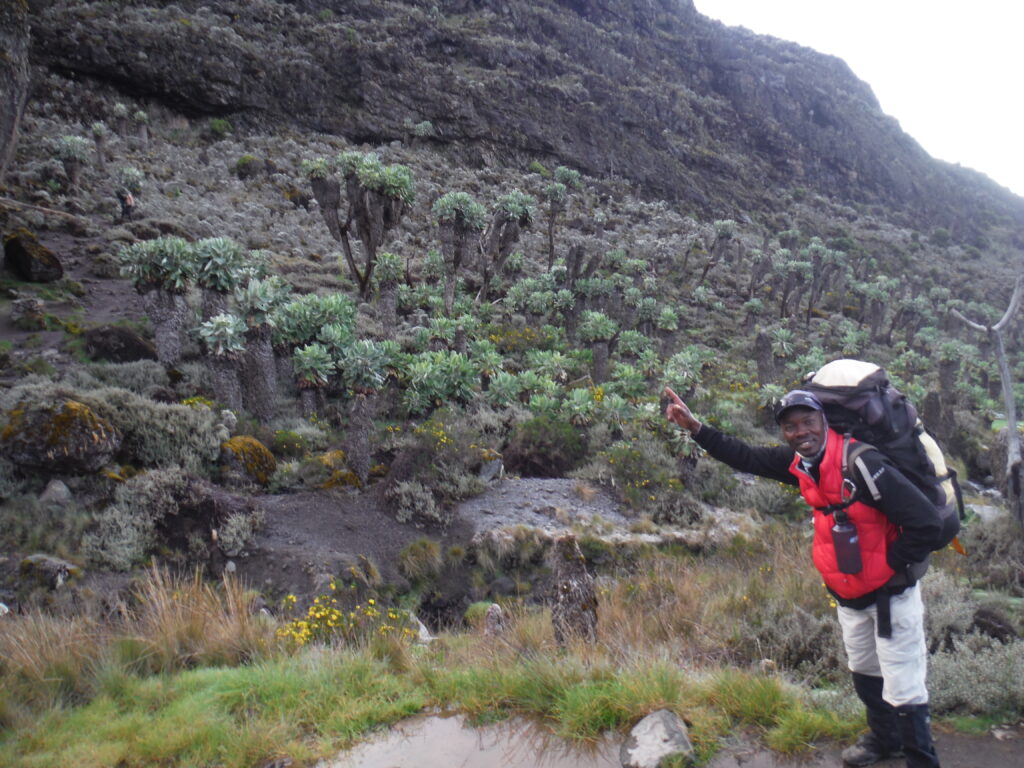
*Giant Senecios
At a small clearing on the trail, our group stopped for a formal introduction to our camp staff. To
be in Kilimanjaro National Park, you must be accompanied by a guide. A few avid climbers insist
on carrying their own gear, but they still must have a guide with them. The most popular way to
hike the mountain is through established guiding services. The typical ratio is about four porters
or guides per visitor. In our case, this meant four hikers were supported by a crew of 18. When I
first learned of this, it seemed excessive. But you quickly see that the crew is carrying all the
tents, food, luggage and even a cassette toilet with its own privacy enclosure, on foot, on
rugged terrain, up to a high point above 15,000 feet.
And you also quickly learn they’re there to help you on the mountain however they can. They
make a living on the mountain, and in the off-season many work on their family farms around
the base of Kilimanjaro, growing food for their families. Our mountain staff was supported by an
organization called the Kilimanjaro Porters Assistance Project, which outlines a
fair wage and tipping system for the crew along with safety measures such as limits (44 pounds)
of what they can carry each day, among other things. Immediately we saw how strong and agile
these porters are, as they passed us on the trail carrying our camp supplies for the next stop.
As we stopped, our group formed a half circle and introduced themselves, and we to them. I
said I was Tim, or Babu – grandpa. The latter stuck, in a respectful and affectionate way. And
then they sang – chants and clapping in an African rhythm about the mountain, about their
homes, and our welcome to it. It was their invitation for us to experience their mountain, and get
a glimpse of their culture. Jambo, jambo bwana … Kilimanjaro hakuna matata! (Hello, hello sir
… Kilimanjaro, there is no problem). Arriving in camp in the early afternoon, we played UNO in
the mess tent with a few of our porters.
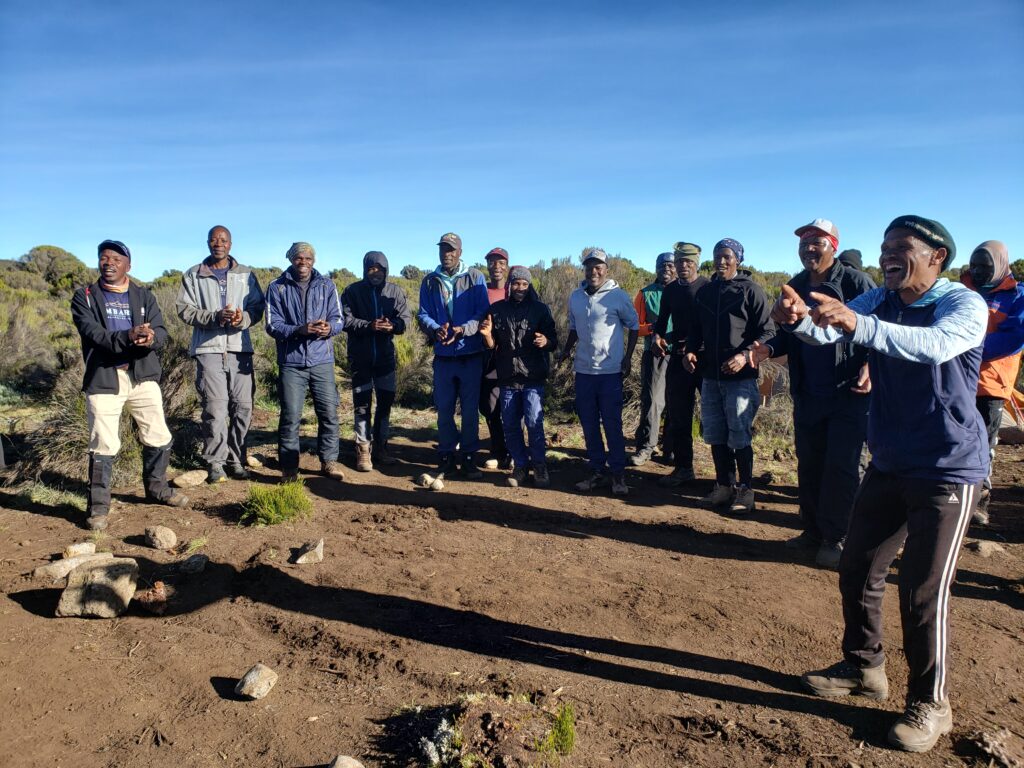
*Porters singing on Mount Kilimanjaro
The routes became increasingly challenging on days four and five. From Shira 2, our destination
across this moonscape was Barranco Camp via Lava Tower, a tough 7 miles. The trail took us
up to 15,200 feet for a quick lunch in the cold fog at Lava Tower Camp, then downhill to
Barranco Camp at 13,000 feet. Each day as we arrived at camp, I had asked our waiter, John,
“What is our dinner tonight?” His daily reply: “It’s a surprise.” At Barranco, I jokingly said, “John,
are we having surprise again tonight? Because we had surprise last night.” He understood my
attempted humor with his soft, deep laugh. But dinner that night was indeed a true surprise. Our
chef, Hagai, had prepared a distinctly African specialty: plantain stew with kachumbari (a red
onion/tomato salad). It was hearty and filling – an African comfort food at a perfect moment.
A note about food on our hike is timely here. Meals on backpacking trips in the mountains for
me have always involved freeze-dried packets carefully doled out each day to save weight. It
was not that way with our group on Kilimanjaro. Hagai cooked multi-course meals three times a
day, all fresh, all delicious, and often unfamiliar. Our guides said we needed to eat amply for the
calories required each day, and Hagai provided the goods.
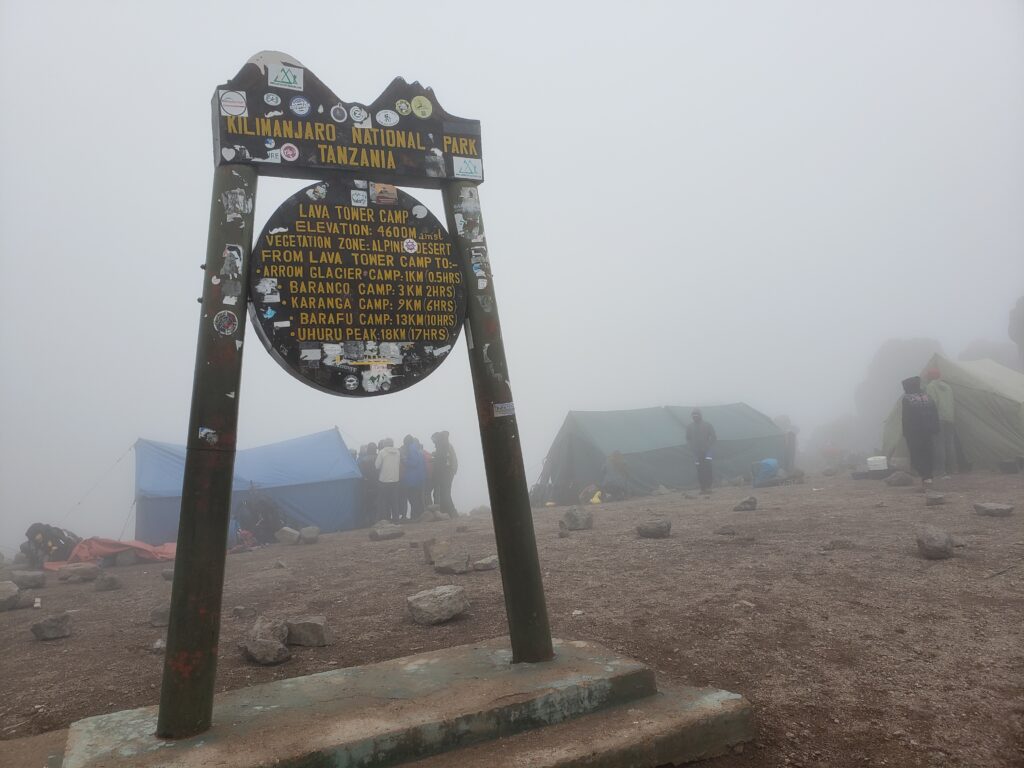
*Lava Tower Camp on Mount Kilimanjaro
Breakfast would feature assorted fruits, porridge and toast, and just when you thought you were
done, waiter John arrived with more: sausage or bacon, eggs and hash browns. The pattern
continued with lunches and dinners. Politely explaining what they were, John paraded in a
variety of soups, potato or rice dishes and salads. The fresh ingredients were sourced from
farms around Kilimanjaro.
Our fifth hiking day presented the biggest challenge yet. This segment takes hikers from
Baranco Camp at 13,000 feet up and over the massive Barranco Wall – an imposing near-
vertical rock formation some 850 feet high that we must work our way over, weaving around
boulders and rocks.
The introduction came immediately: the so-called Barranco Kissing Wall, a narrow section of
trail up tight against the rock wall, with a rocky drop-off behind us. Our guides took our trekking
poles so we had hands free to grasp rock handholds, stomachs facing the wall. We went over
the strategy of where to step and what to grab, and in what order. “One, two, three go,” I
muttered to myself, and inched along the wall, carefully taking the 10 or 15 steps to pass the
section. No kisses from me.
The rest of the trail over Barranco required more scrambling until we reached the top and began
a welcome descent to Karanga Camp, 3.5 miles away at 13,280 feet. At Karanga, we were
finally within striking distance of Kili’s summit. A crazy rapid-fire sequence of events over 30
hours would get us there and then on our way off the mountain.

*Tim at Karanga Camp on Mount Kilimanjaro
An Intense 30 Hours on the Mountain
It began in the morning when we left Karanga for a three-mile hike across the plain to Barafu
Camp at 15,300 feet, arriving for lunch. I’ve been anxiously curious about Barafu, which means
“ice” and was our highest elevation yet. Several Kili routes converge here for a base to the
summit. There was a nervous sense of excitement at Barafu as the fog came and went up the
slope. In the afternoon, I could see hikers coming down the summit trail. “That will be me
tomorrow,” I think.
After lunch, guide Mark crawled into my tent to go over clothing for the summit climb. We chose
all the layers: a light base on bottom and top, mid-layers over them, a rugged pair of mountain
pants, an insulating down jacket, a balaclava that doubles as a hat for me, and a headlamp. I
stuffed a heavier wind jacket into my backpack, along with my water platypus. Mark nodded in
approval, while I was thinking I’ve never hiked with this much clothing on in my life. And then
again, I’ve never been at 15,300 feet. “You’re ready!” he says.
We had an early, light dinner and our nightly medical check. Finishing the chart, Mark went over
our strategy for the summit that night. “Do you feel ready?” he asked. As ready as I’ll ever be, I
thought. “We’ll leave at 11 tonight, so we’ll wake you at 10:30. At our pace, we should reach the
summit right around sunrise. It will be the most amazing one you’ll ever see.”
Going to my tent, I snapped photos of the sunset behind the evening clouds that blanketed the
mountain. “See you in a few hours from the top,” I whispered, then it was off to grab some quick
rest. I was deeply asleep when Mark came to awaken me. It was time.
The night was wonderfully calm, and behind us the lights of Moshi spread out in the valley far
below. The trail steadily rises in a direct sense – no time for meandering here – but thankfully
not too steep. I was also thankful that there’s minimal scrambling, which would sap energy and
be challenging in the dark. “Just a nice, eight-hour walk,” I thought. Hakuna matata.
About two hours in, and a thousand feet higher, I’m worried that I can’t find a comfortable
walking pace. I’m not short of breath, as I expected at this higher altitude. My heart rate feels
elevated, and while I don’t feel I’m in any immediate danger, I don’t think I could keep going like
this for six or seven more hours. I go through my inventory of past big athletic endeavors –
grueling triathlons and long, hard bike rides, 20-hour mountain hikes – in search of solutions.
Where had I faced this before, and what was the response? I remembered a total breakdown
during a half-iron triathlon in Sunriver, Oregon, where I inexplicably had nothing in the tank after
the bike ride, despite being in top shape. I had started walking on the run route to find the finish
area and tell race officials that I was scratching out, but then ended up walk/jogging the 13-mile
segment. And I recalled a similar experience on a long uphill stretch called the Spooner grade
on the 100-mile America’s Most Beautiful Bike Ride around Lake Tahoe. But this was different. I
was not exhausted or “bonking” – that unfortunate state when your tank is empty and you simply
don’t have anything left. I don’t know what it was. That was the problem: I didn’t know. And in
past races, I could always just walk, or get off the bike. Turning around was the only option here.
“Mark, I’m having some problems,” I said. “I can’t get my heart rate right. I think it’s the
combination of altitude and exertion. Can we go even more pole, pole, pole – and I know we
don’t want to stop too much, but perhaps if we can just take standing breaks for 30 seconds,
that would help.” Octavian offered to take my water bottle to lighten my load even by a pound,
and it helped. We continued on, and I was able to find a more comfortable cadence helped by a
prayer chant with every step. Still, twice I was ready to stop and say I couldn’t go any further. It
didn’t help that I occasionally looked up and saw the headlamps of the other hikers in front of us appearing seemingly straight up and unfathomably distant. “Damn, they’re not even at the top,” I
think. And glancing behind, there’s no trace of dawn on the horizon, just a black, unresponsive
sky. My water line to my platypus froze, meaning no more quick sips of water.
But somehow, we kept going, step by step, pausing as needed. The minutes, then hours passed
and finally light appeared in the sky behind us. Sunrise shook off the dark and brought new
energy, because I knew it meant we were near the top, and now we could see our surroundings.
We reached the summit at 6:40 a.m. at Stella Point, 18,885 feet. It was a nearly cloudless day,
with moderate wind, cool but not frigid. This vantage point is on the rim of Kilimanjaro’s massive
southern crater, so in one direction we looked into the heart of the mountain, while in another we
could see the plains beyond Moshi.
“Congratulations!” Mark and Octavian said, sharing hugs. We set our packs on a rock bench,
then posed for pictures at the iconic “Congratulations, you are now at Stella Point” sign giving
the official altitude. Stella, named after Estella Kingsley Latham, the first woman on record to
reach the point in 1925, is one of three official summit points on Kilimanjaro. The highest is
Uhuru Peak at 19,341 feet, about an hour further. For me, the decision to not continue was
easy. It just wasn’t smart to take more risks.
We abandoned pole, pole, pole on the descent, letting our legs stretch out in full strides down
the well-worn trail. At about a half mile above Barafu Camp, our porters greeted us where the
hardpack trail gives way to scree fields. They had met us this way each day to offer to take our
packs into camp. Today was different: They would physically help us to camp. “Come along,
Babu, we will help you,” said one, Emmanual. He and another porter, Dismas, locked my arms
in theirs, one on my left, the other on my right, and we effortlessly boot-stepped through the
loose rocks. We were back at Barafu in well under three hours. The other porters applauded as
we reached camp at 9 a.m.

*Tim at Stella Point on Mount Kilimanjaro
The day continued with a quick breakfast and catnap, then at noon we broke camp to descend
four more miles to Mweka Hut Camp at 10,200 feet. It was the final step in the summit
sequence that took us from Karanga to Barafu to Stella Point, then back to Barafu, then back to
the jungle at Mweka. We descended some 8,000 feet in a day. I would sleep deeply in the
thicker air that night.
Leaving the Mountain
“Babu, may I enter?” John, our server, is at my tent vestibule with his morning offer of tea or
coffee, and hot water for bathing. “Tea, I assume? And Kilimanjaro blend?”
I surprised him. “John, today I think I will try your Kilimanjaro coffee. And let’s live it up: I’ll take
two teaspoons of cream. Because today is different. We’re leaving the mountain.” He laughed
his quiet laugh. “Asante, John (thank you).” “Karibu,” he replied.
Overnight, it had rained heavily on our tents, a deep jungle rain. I had laid in bed listening to the
raindrops. It was our last night on Kilimanjaro. It was now a time of descending, not ascending;
going toward home, not away; getting answers, not questions. Into the night I wrote in my
journal and took another look into the past days, to the people I had met and the mountain
songs that they sang, and to the help they always offered, and how they called me Babu,
respectfully. I thought about the trail and the fascinating mountain zones, the clear streams from
Kilimanjaro snow that we crossed, the chorus of colobus monkeys in the jungle, the daunting Baranco Wall and cold Barafu. And I thought of the summit night, a hard, dark night, and the
voice that never came to say turn around, and how slowly the hours passed, and maybe how
fortunate I had been. I thought about how the whole trip came together, that it had been on my
bucket list as an event to raise money for a good cause, and that I was able to visit Kilimanjaro
because my leukemia was curable. And that I had been searching for a challenge, and received
it.
We left in the morning to hike the last six miles to Mweka Gate at 5,400 feet, carefully avoiding
slipping on the rain-slick trail. Mark told us he had heard by radio from other guides that it had
snowed the previous night on Kili. In a clearing we saw the mountain in a stunning new cloak of
white. What a striking last look at Kilimanjaro – a pure, white figure above the African plain.
Walking under the Mweka Gate sign, we left the rugged exposure of being on Africa’s highest
mountain to the civilized park building and manicured grounds. And it was time to find a beer,
preferably the Kilimanjaro brand I had heard about. Its tag line on the label is, “If you can’t climb
it, drink it.” I would do both.
So long, Kilimanjaro. Asante, my porters and guides. Asante sana. Thank you very much.
Trip Tips from Tim
– Follow the Embark 4-Month Training Guide to be in hiking shape for the mountain. But
back off during training if you’re getting any injuries.
– Research the options for taking medication that helps offset altitude sickness.
– Don’t place vital items in your check-in luggage, in case it gets lost. Keep those items in
your carry-on luggage. This includes your hiking boots and medications. Also, don’t pack
electronics with batteries in your check-in luggage. These can be taken out by inspectors
out of fears of battery-related fires.
– Learn some basic Swahili phrases before you go. The porters and guides will appreciate
your interest in their culture.
– Do some preliminary research on Tanzania, its history and culture.
*This personal account was written by Tim Talevich, a writer and editor in North Bend, WA.

